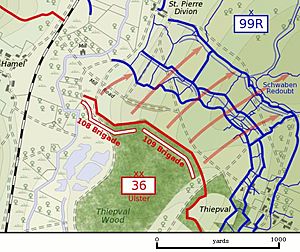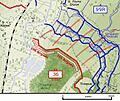Oliver Nugent facts for kids
Quick facts for kids
Sir
Oliver Stewart Wood Nugent
KCB DSO
|
|
|---|---|
| Born | 9 November 1860 Aldershot, Hampshire, England |
| Died | 31 May 1926 (aged 65) |
| Allegiance | |
| Service/ |
|
| Years of service | 1882−1920 |
| Rank | Major-General |
| Unit | Royal Munster Fusiliers King's Royal Rifle Corps |
| Commands held | 41st Brigade 36th (Ulster) Division Meerut Division |
| Battles/wars | Chitral Expedition Hazara Expedition of 1888 Second Boer War First World War * Battle of the Somme |
| Awards |
|
Major-General Sir Oliver Stewart Wood Nugent (born November 9, 1860 – died May 31, 1926) was a brave officer in the British Army. He is best known for leading the 36th (Ulster) Division during the First World War. His leadership was especially important during the famous Battle of the Somme.
Contents
Early Life and Army Start
Oliver Nugent was born in England in 1860. His father, St George Nugent, was also a Major General in the army. Oliver went to two well-known schools: Harrow and Sandhurst. Sandhurst is a special military college where future army officers learn their skills.
In 1882, Oliver joined the British Army. His first role was as a lieutenant in the Royal Munster Fusiliers. Soon after, in 1883, he moved to the King's Royal Rifle Corps.
Adventures and Awards
Oliver Nugent quickly rose through the ranks. He became a captain in 1890. He took part in several military expeditions, which are like special missions. These included the Hazara, Miranzai, and Chitral expeditions.
During these missions, he was recognized for his bravery. He was "mentioned in dispatches" twice. This means his name was written in official reports for doing something very brave or important. He also received the Distinguished Service Order (DSO), a special award for officers who show great courage.
In 1899, he became a major. He then fought in the Second Boer War. During one battle, the battle of Talana Hill, he was injured and captured.
World War I Hero
When the First World War began, Oliver Nugent was serving in England. In 1915, he was sent to the Western Front in Europe. This was where much of the fighting happened. He was put in charge of the 41st Brigade.
Later in 1915, he was given a very important job. He became the commander of the 36th (Ulster) Division. He led this division until 1918. On January 1, 1916, he was promoted to Major-General.
The Battle of the Somme
During the Battle of the Somme in 1916, General Nugent came up with a clever plan. He ordered his Ulster Division to attack twenty minutes before the main attack was supposed to start. This early move gave his soldiers an advantage. They managed to capture their main target, a strong enemy position called the Schwaben Redoubt.
However, other parts of the attack along the front line did not go as well. This meant the 36th Division had to pull back. Even so, their bravery and success in capturing the Schwaben Redoubt were very impressive. For his service, he received another honor in 1917.
Later Life and Legacy
After the First World War, General Nugent continued his service. From 1918 to 1920, he commanded the Meerut Division in India. He retired from the army in 1920.
He then moved back to his family home in Ireland. Sir Oliver Stewart Wood Nugent passed away on May 31, 1926, from pneumonia. He was knighted in 1922, which means he was given the title "Sir" for his great achievements. A portrait of him, painted by William Conor, can be seen in Belfast City Hall.
Images for kids



